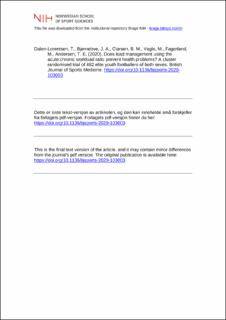Does load management using the acute:chronic workload ratio prevent health problems?: A cluster randomised trial of 482 elite youth footballers of both sexes
Dalen-Lorentsen, Torstein; Bjørneboe, John Andreas; Clarsen, Benjamin Matthew; Vagle, Markus; Fagerland, Morten; Andersen, Thor Einar
Peer reviewed, Journal article
Accepted version
Permanent lenke
https://hdl.handle.net/11250/2720692Utgivelsesdato
2020Metadata
Vis full innførselSamlinger
- Artikler / Articles [2119]
- Publikasjoner fra Cristin [1107]
Originalversjon
British Journal of Sports Medicine. 2020. https://doi.org/10.1136/bjsports-2020-103003 10.1136/bjsports-2020-103003Sammendrag
Background: The acute:chronic workload ratio (ACWR) is commonly used to manage training load in sports, particularly to reduce injury risk. However, despite its extensive application as a prevention intervention, the effectiveness of load management using ACWR has never been evaluated in an experimental study. Aim: To evaluate the effectiveness of a load management intervention designed to reduce the prevalence of health problems among elite youth football players of both sexes. Methods: We cluster-randomised 34 elite youth football teams (16 females, 18 males) to an intervention group (18 teams) and a control group (16 teams). Intervention group coaches planned all training based on published ACWR load management principles using a commercially available athlete management system for a complete 10-month season. Control group coaches continued to plan training as normal. The prevalence of health problems was measured monthly in both groups using the Oslo Sports Trauma Research Centre Questionnaire on Health Problems. Results: The between-group difference in health problem prevalence (primary outcome) was 1.8%-points (−4.1 to 7.7 %-points; p=0.55) with no reduction in the likelihood of reporting a health problem in the intervention group (relative risk 1.01 (95% CI 0.91 to 1.12); p=0.84) compared with the control group. Conclusions: We observed no between-group difference, suggesting that this specific load management intervention was not successful in preventing health problems in elite youth footballers.
Beskrivelse
I Brage finner du siste tekst-versjon av artikkelen, og den kan inneholde ubetydelige forskjeller fra forlagets pdf-versjon. Forlagets pdf-versjon finner du på bjsm.bmj.com / In Brage you'll find the final text version of the article, and it may contain insignificant differences from the journal's pdf version. The definitive version is available at bjsm.bmj.com
